Are you searching for class 10 chapter – 2 polynomial solutions? you’re at the right place. You can get accurate CBSE NCERT Solutions for all subjects. These solutions will help you a lot in scoring good marks in the exams.
Page No: 28
Polynomial solutions – Exercises 2.1
1. The graphs of y = p(x) are given in the following figure, for some polynomials p(x). Find the number of zeroes of p(x), in each case.
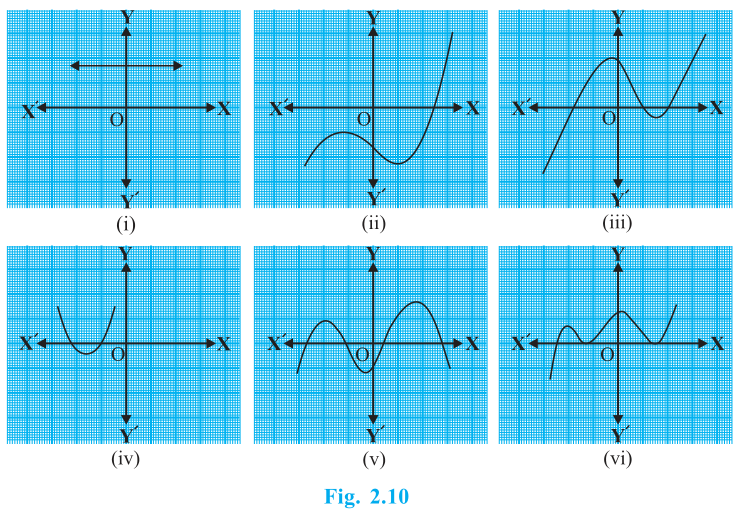
(i) The number of zeroes is 0 as the graph does not cut the x-axis at any point.
(ii) The number of zeroes is 1 as the graph intersects the x-axis at only 1 point.
(iii) The number of zeroes is 3 as the graph intersects the x-axis at 3 points.
(iv) The number of zeroes is 2 as the graph intersects the x-axis at 2 points.
(v) The number of zeroes is 4 as the graph intersects the x-axis at 4 points.
(vi) The number of zeroes is 3 as the graph intersects the x-axis at 3 points.
[the_ad id=”619″]
Page No: 33
Polynomial solutions – Exercise 2.2
1. Find the zeroes of the following quadratic polynomials and verify the relationship between the zeroes and the coefficients.
(i) x2 – 2x – 8
(ii) 4s2 – 4s + 1
(iii) 6x2 – 3 – 7x
(iv) 4u2 + 8u
Answer
(i) x2 – 2x – 8
= (x – 4) (x + 2)
The value of x2 – 2x – 8 is zero when x – 4 = 0 or x + 2 = 0, i.e., when x = 4 or x = -2
Therefore, the zeroes of x2 – 2x – 8 are 4 and -2.
(ii) 4s2 – 4s + 1
= (2s-1)2
The value of 4s2 – 4s + 1 is zero when 2s – 1 = 0, i.e., s = 1/2
Sum of zeroes = 1/2 + 1/2 = 1 = -(-4)/4 = -(Coefficient of s)/Coefficient of s2
Product of zeroes = 1/2 × 1/2 = 1/4 = Constant term/Coefficient of s2.
(iii) 6x2 – 3 – 7x
= 6x2 – 7x – 3
= (3x + 1) (2x – 3)
The value of 6x2 – 3 – 7x is zero when 3x + 1 = 0 or 2x – 3 = 0, i.e., x = -1/3 or x = 3/2
Sum of zeroes = -1/3 + 3/2 = 7/6 = -(-7)/6 = -(Coefficient of x)/Coefficient of x2
Product of zeroes = -1/3 × 3/2 = -1/2 = -3/6 = Constant term/Coefficient of x2.
(iv) 4u2 + 8u
= 4u2 + 8u + 0
= 4u(u + 2)
The value of 4u2 + 8u is zero when 4u = 0 or u + 2 = 0, i.e., u = 0 or u = – 2
Therefore, the zeroes of 4u2 + 8u are 0 and – 2.
Sum of zeroes = 0 + (-2) = -2 = -(8)/4 = -(Coefficient of u)/Coefficient of u2
Product of zeroes = 0 × (-2) = 0 = 0/4 = Constant term/Coefficient of u2.
(v) t2 – 15
= t2 – 0.t – 15
= (t – √15) (t + √15)
The value of t2 – 15 is zero when t – √15 = 0 or t + √15 = 0, i.e., when t = √15 or t = -√15
Therefore, the zeroes of t2 – 15 are √15 and -√15.Sum of zeroes = √15 + -√15 = 0 = -0/1 = -(Coefficient of t)/Coefficient of t2
Product of zeroes = (√15) (-√15) = -15 = -15/1 = Constant term/Coefficient of u2.
(vi) 3x2 – x – 4
= (3x – 4) (x + 1)
The value of 3x2 – x – 4 is zero when 3x – 4 = 0 and x + 1 = 0,i.e., when x = 4/3 or x = -1
Therefore, the zeroes of 3x2 – x – 4 are 4/3 and -1.
Product of zeroes = 4/3 × (-1) = -4/3 = Constant term/Coefficient of x2.
2. Find a quadratic polynomial each with the given numbers as the sum and product of its zeroes respectively.
(i) 1/4 , -1
Answer
(i) 1/4 , -1
Let the polynomial be ax2 + bx + c, and its zeroes be α and ß
α + ß = 1/4 = –b/a
αß = -1 = -4/4 = c/a
If a = 4, then b = -1, c = -4
Therefore, the quadratic polynomial is 4x2 – x -4.
(ii) √2 , 1/3
Let the polynomial be ax2 + bx + c, and its zeroes be α and ß
α + ß = √2 = 3√2/3 = –b/a
αß = 1/3 = c/a
If a = 3, then b = -3√2, c = 1
Therefore, the quadratic polynomial is 3x2 -3√2x +1.
(iii) 0, √5
Let the polynomial be ax2 + bx + c, and its zeroes be α and ß
α + ß = 0 = 0/1 = –b/a
αß = √5 = √5/1 = c/a
If a = 1, then b = 0, c = √5
Therefore, the quadratic polynomial is x2 + √5.
(iv) 1, 1
Let the polynomial be ax2 + bx + c, and its zeroes be α and ß
α + ß = 1 = 1/1 = –b/a
αß = 1 = 1/1 = c/a
If a = 1, then b = -1, c = 1
Therefore, the quadratic polynomial is x2 – x +1.
(v) -1/4 ,1/4
Let the polynomial be ax2 + bx + c, and its zeroes be α and ß
α + ß = -1/4 = –b/a
αß = 1/4 = c/a
If a = 4, then b = 1, c = 1
Therefore, the quadratic polynomial is 4x2 + x +1.
(vi) 4,1
Let the polynomial be ax2 + bx + c, and its zeroes be α and ß
α + ß = 4 = 4/1 = –b/a
αß = 1 = 1/1 = c/a
If a = 1, then b = -4, c = 1
Therefore, the quadratic polynomial is x2 – 4x +1.
Page No: 36
[the_ad id=”619″]
Download NCERT chapter 2 – Polynomial solution –Download Now
Polynomial solutions – Exercise 2.3
1. Divide the polynomial p(x) by the polynomial g(x) and find the quotient and remainder in each of the following:
Answer
(i) p(x) = x3 – 3x2 + 5x – 3, g(x) = x2 – 2

Quotient = x-3 and remainder 7x – 9
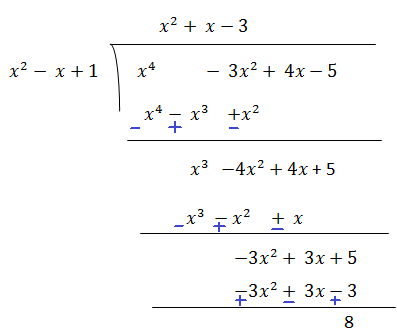
Quotient = x2 + x – 3 and remainder 8

Quotient = –x2 -2 and remainder -5x +10
2. Check whether the first polynomial is a factor of the second polynomial by dividing the
second polynomial by the first polynomial:
(i) t2 – 3, 2t4 + 3t3 – 2t2 – 9t – 12
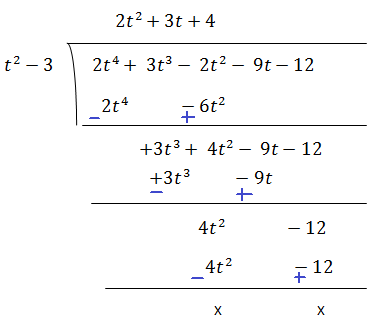
t2 – 3 exactly divides 2t4 + 3t3 – 2t2 – 9t – 12 leaving no remainder. Hence, it is a factor of 2t4 + 3t3 – 2t2 – 9t – 12.
(ii) x2 + 3x + 1, 3x4 + 5x3 – 7x2 + 2x + 2
(iii) x3 – 3x + 1, x5 – 4x3 + x2 + 3x + 1
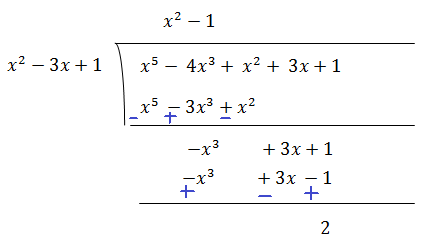
and – √(5/3).
Answer
p(x) = 3x4 + 6x3 – 2x2 – 10x – 5
Since the two zeroes are √(5/3) and – √(5/3).
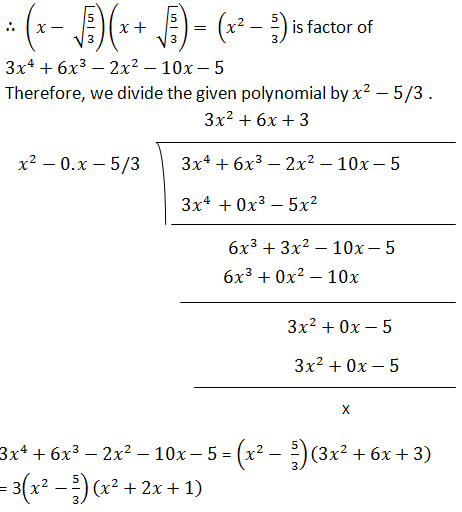
As it has the term (x + 1)2 , therefore, there will be 2 zeroes at x = – 1.
Hence, the zeroes of the given polynomial are √(5/3) and – √(5/3), – 1 and – 1.
4. On dividing x3 – 3x2 + x + 2 by a polynomial g(x), the quotient and remainder were x – 2 and
-2x + 4, respectively. Find g(x).
Answer
Here in the given question,
⇒ x3 – 3x2 + 3x – 2 = (x – 2) × g(x)
⇒ g(x) = (x3 – 3x2 + 3x – 2)/(x – 2)
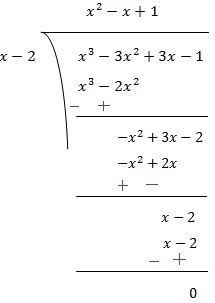
∴ g(x) = (x2 – x + 1)
5.Give examples of polynomial p(x), g(x), q(x) and r(x), which satisfy the division algorithm and
(i) deg p(x) = deg q(x)
(ii) deg q(x) = deg r(x)
(iii) deg r(x) = 0
Answer
Here, p(x) = 6x2 + 2x + 2
g(x) = 2
q(x) = 3x2 + x + 1
r(x) = 0
Degree of p(x) and q(x) is same i.e. 2.
Checking for division algorithm,
p(x) = g(x) × q(x) + r(x)
Or, 6x2 + 2x + 2 = 2x (3x2 + x + 1)
Hence, division algorithm is satisfied.
(ii) Let us assume the division of x3+ x by x2,
Here, p(x) = x3 + x
g(x) = x2
q(x) = x and r(x) = x
Clearly, the degree of q(x) and r(x) is the same i.e., 1.
Checking for division algorithm,
p(x) = g(x) × q(x) + r(x)
x3 + x = (x2 ) × x + x
x3 + x = x3 + x
Thus, the division algorithm is satisfied.
(iii) Let us assume the division of x3+ 1 by x2.
Here, p(x) = x3 + 1
g(x) = x2
q(x) = x and r(x) = 1
Clearly, the degree of r(x) is 0.
Checking for division algorithm,
p(x) = g(x) × q(x) + r(x)
x3 + 1 = (x2 ) × x + 1
x3 + 1 = x3 + 1
Thus, the division algorithm is satisfied.
Page No: 36
Read also – Real number solution
Download NCERT chapter 2 – Polynomial solution –Download Now
Polynomial solutions – Exercise 2.4 (Optional)
1. Verify that the numbers given alongside of the cubic polynomials below are their zeroes. Also verify the relationship between the zeroes and the coefficients in each case:
(i) 2x3 + x2 – 5x + 2; 1/2, 1, -2
(ii) x3 – 4x2 + 5x – 2; 2, 1, 1
Answer
(i) p(x) = 2x3 + x2 – 5x + 2
Now for zeroes, putting the given value in x.
p(1/2) = 2(1/2)3 + (1/2)2 – 5(1/2)+ 2
= (2×1/8) + 1/4 – 5/2 + 2
= 1/4 + 1/4 – 5/2 + 2
= 1/2 – 5/2 + 2 = 0
p(1) = 2(1)3 + (1)2 – 5(1)+ 2
= (2×1) + 1 – 5 + 2
= 2 + 1 – 5 + 2 = 0
p(-2) = 2(-2)3 + (-2)2 – 5(-2)+ 2
= (2 × -8) + 4 + 10 + 2
= -16 + 16 = 0
Thus, 1/2, 1 and -2 are the zeroes of the given polynomial.
Comparing the given polynomial with ax3 + bx2 + cx + d, we get a=2, b=1, c=-5, d=2
Also, α=1/2, β=1 and γ=-2
Now,
-b/a = α+β+γ
⇒ 1/2 = 1/2 + 1 – 2
⇒ 1/2 = 1/2
c/a = αβ+βγ+γα
⇒ -5/2 = (1/2 × 1) + (1 × -2) + (-2 × 1/2)
⇒ -5/2 = 1/2 – 2 – 1
⇒ -5/2 = -5/2
-d/a = αβγ
⇒ -2/2 = (1/2 × 1 × -2)
⇒ -1 = 1
Thus, the relationship between zeroes and the coefficients are verified.
[the_ad id=”619″]
(ii) p(x) = x3 – 4x2 + 5x – 2
Now for zeroes, putting the given value in x.
p(2) = 23 – 4(2)2 + 5(2)- 2
= 8 – 16 + 10 – 2
= 0
p(1) = 13 – 4(1)2 + 5(1)- 2
= 1 – 4 + 5 – 2
= 0
p(1) = 13 – 4(1)2 + 5(1)- 2
= 1 – 4 + 5 – 2
= 0
Thus, 2, 1 and 1 are the zeroes of the given polynomial.
Comparing the given polynomial with ax3 + bx2 + cx + d, we get a=1, b=-4, c=5, d=-2
Also, α=2, β=1 and γ=1
Now,
-b/a = α+β+γ
⇒ 4/1 = 2 + 1 + 1
⇒ 4 = 4
c/a = αβ+βγ+γα
⇒ 5/1 = (2 × 1) + (1 × 1) + (1 × 2)
⇒ 5 = 2 + 1 + 2
⇒ 5 = 5
-d/a = αβγ
⇒ 2/1 = (2 × 1 × 1)
⇒ 2 = 2
Thus, the relationship between zeroes and the coefficients are verified.
2. Find a cubic polynomial with the sum, sum of the product of its zeroes taken two at a time, and the product of its zeroes as 2, –7, –14 respectively.
Answer
Let the polynomial be ax3 + bx2 + cx + d and the zeroes be α, β and γ
Then, α + β + γ = -(-2)/1 = 2 = -b/a
αβ + βγ + γα = -7 = -7/1 = c/a
αβγ = -14 = -14/1 = -d/a
∴ a = 1, b = -2, c = -7 and d = 14
So, one cubic polynomial which satisfy the given conditions will be x3 – 2x2 – 7x + 14
3. If the zeroes of the polynomial x3 – 3x2 + x + 1 are a–b, a, a+b, find a and b.
Answer
Since, (a – b), a, (a + b) are the zeroes of the polynomial x3 – 3x2 + x + 1.
Therefore, sum of the zeroes = (a – b) + a + (a + b) = -(-3)/1 = 3
⇒ 3a = 3 ⇒ a =1
∴ Sum of the products of is zeroes taken two at a time = a(a – b) + a(a + b) + (a + b) (a – b) =1/1 = 1
a2 – ab + a2 + ab + a2 – b2 = 1
⇒ 3a2 – b2 =1
Putting the value of a,
⇒ 3(1)2 – b2 = 1
⇒ 3 – b2 = 1
⇒ b2 = 2
⇒ b = ±√2
Hence, a = 1 and b = ±√2
4. If two zeroes of the polynomial x4 – 6x3 – 26x2 + 138x – 35 are 2±√3, find other zeroes.
Answer
2+√3 and 2-√3 are two zeroes of the polynomial p(x) = x4 – 6x3 – 26x2 + 138x – 35.
Let x = 2±√3
So, x-2 = ±√3
On squaring, we get x2 – 4x + 4 = 3,
⇒ x2 – 4x + 1= 0
Now, dividing p(x) by x2 – 4x + 1
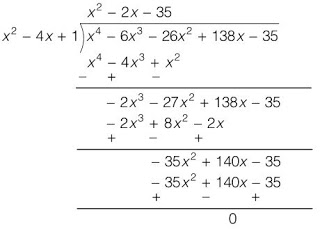
∴ p(x) = x4 – 6x3 – 26x2 + 138x – 35
= (x2 – 4x + 1) (x2 – 2x – 35)
= (x2 – 4x + 1) (x2 – 7x + 5x – 35)
= (x2 – 4x + 1) [x(x – 7) + 5 (x – 7)]
= (x2 – 4x + 1) (x + 5) (x – 7)
∴ (x + 5) and (x – 7) are other factors of p(x).
∴ – 5 and 7 are other zeroes of the given polynomial.
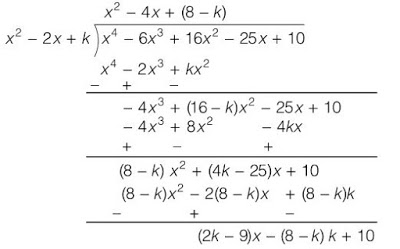
Download NCERT chapter 2 – Polynomial solution –Download Now
Go Back To NCERT Solutions for Class 10th Maths
Disclaimer – These questions are taken from Ncert official website.




